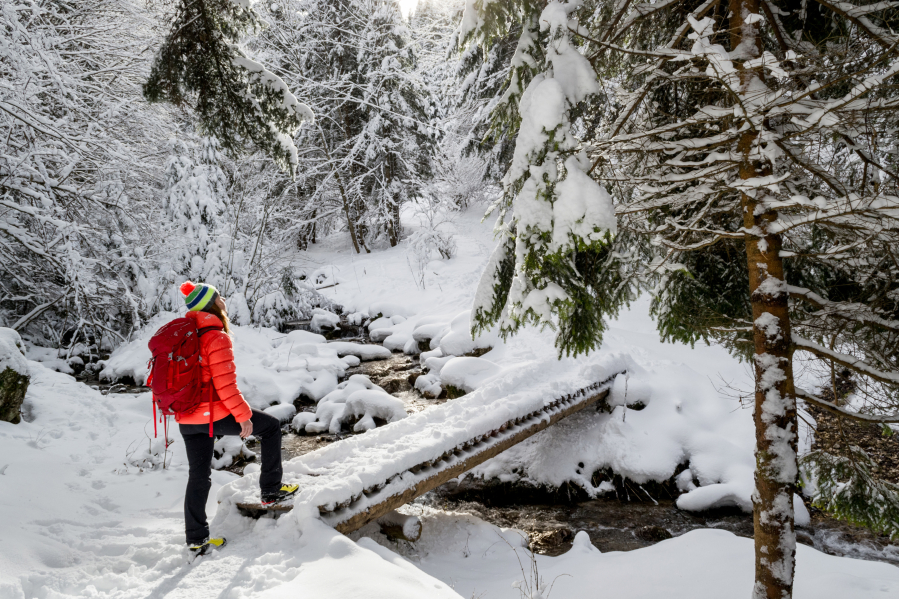Even though hiking skyrocketed in popularity during the pandemic, fewer people are willing to brave icy conditions and slippery trails when the temperature drops.
That’s a shame because the winter may be one of the best times to experience nature’s beauty, according to Steve Henry, the author of the St. Louis edition of “60 Hikes Within 60 Miles.” The winter is his favorite hiking season because the cold banishes bugs and mosquitos, bare trees expose scenic vistas and freezing water creates beautiful icicles.
“After ice storms, the forest glitters as if encrusted with diamonds,” he writes in the preface to the book many hikers consider a bible.
Winter hikes require more preparation than other seasons and call for some special considerations. We talked to dozens of enthusiasts from the Missouri Hikers Facebook group, experts from Great River Greenway, the Missouri Department of Conservation and Missouri State Parks and consulted Henry’s book to get the best tips on how to safely enjoy the winter wonderland outside.
• Charge your cellphone
Cold temperature drains batteries faster. Keep the phone near your body for additional warmth. Be smart about battery usage by dimming your screen, turning off push notification and using low power mode.
• Share your location and timings
If you plan to hike alone, let a family member or trusted friend know where you will be going and the window of time you expect to return.
• Take a map
Download or print out a map of the trail and park you plan to visit. The Missouri State Parks site offers maps of the trails in state parks. Make sure your hiking app is updated (AllTrails is a good one) and you have a reliable GPS. Paper maps are vital in areas with weak or no cell signal.
• Dress appropriately
Layers are critical in the winter. Begin with a base layer that wicks sweat away from your body, a middle layer to keep heat in and an outer layer to protect against wind and rain. You should be able to adjust and remove layers to avoid getting too sweaty or cold. Don’t forget a warm hat, gloves and a neck gaiter. Avoid cotton when hiking in the winter.
• Wear the right shoes and socks
Invest in quality socks, such as wool hiking socks. Try on different brands of hiking boots to find the right fit and grip. Some trail conditions may require ice cleats, snow grips or snowshoes. Common injuries are from slipping and falling.
• Pack a backpack
You can buy mini, pre-packaged kits with the essentials, such as first-aid supplies. It’s also handy to have a place for water, snacks and a multipurpose tool or knife.
• Hydrate
It’s normal to feel less thirsty in cooler temperatures, but hydration is just as important as in the summer. Carry water depending on your distance and location and use an insulated container to prevent it from freezing.
• Plan your time conservatively
Remember the days are shorter, and it begins to get dark earlier in the winter. Build in extra time in case you get lost or make more frequent stops, so you can still return before dark.
• Try out trekking poles
Using one or two trekking poles can help maintain balance and stability while hiking. A pole can also help gauge the depth of a water crossing is or the thickness of the ice on a frozen stream.
• Check the forecast
Before heading out, check the forecast for your intended destination for the duration of time you plan to be there. Trail conditions will change as ice or snow melts later in the day.
• Watch out for trees
Towering, snow-covered trees are magnificent to behold, but be careful around trees loaded with ice or snow. Loose or broken limbs can fall and injure or even kill hikers. Take a minute to look up when you stop to catch a view. Also be wary of standing near large icicles, which may be melting and at risk for falling.
• Think about the ride back
If you want to avoid tracking mud into your car after a hike, bring a change of shoes or lay down disposable bags. If you are hiking with a dog, you may want to bring an extra towel for your pet.
• Pack snacks
It’s useful to keep extra snacks on hand that won’t freeze easily, such as nuts or chocolate.
• Use the bathroom before heading out
Check in advance if restrooms are open and available in the park you are visiting.
• Use sun protection
Don’t forget to apply sunscreen before heading out, even when it is overcast. Sun protection is required year-round when spending any time outdoors.
• Stay dry
It can be difficult to regulate body temperature when hiking in the cold. If your layers are too heavy while walking, you may start sweating, which can freeze and make you even colder. Consider saving warmer layers for when you stop to rest, enjoy a view or take a picture.
• Know the signs of hypothermia
If you or a hiking buddy start shivering or getting confused or forgetful, get to shelter or warm up immediately. Hypothermia can quickly become dangerous.
• Keep a light source
Have a small flashlight in your backpack in case your hike ends up longer than planned or you get turned around. If you plan to hike at night, it may be worthwhile to get a headlamp to keep your hands free.
• Have a mask handy
Even a disposable mask can keep your nose and face warm. It can be easily pulled down or up if passing people on a narrow path.
• Know yourself
If your nose runs in the cold regardless of how much you bundle up, pack some tissues. Or if your lips dry out quickly, carry a lip balm.



